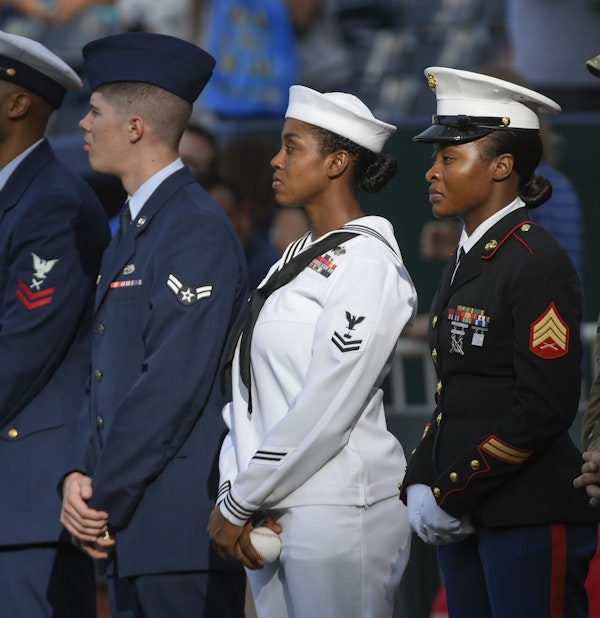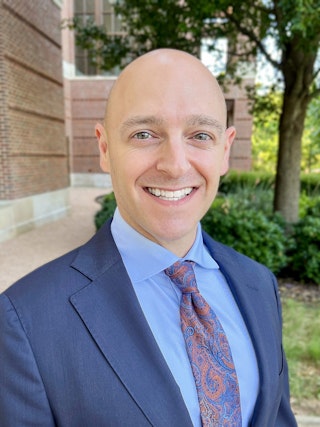Unity in the trenches
The world’s most pluralistic society is protected by its most diverse organization: the U.S. military
 Five service members honored in a pre-game ceremonies for Armed Forces Night at Kauffman Stadium in Kansas City, Missouri on July 3, 2019. (Reed Hoffmann / Getty Images)
Five service members honored in a pre-game ceremonies for Armed Forces Night at Kauffman Stadium in Kansas City, Missouri on July 3, 2019. (Reed Hoffmann / Getty Images)
Following many dinners in Kabul, Afghanistan, Mark and I would philosophize about life. We discussed our purpose, our personal and professional goals, and our dreams for our families. I looked forward to those evening walks during the second half of my yearlong deployment to the NATO Training Mission-Afghanistan in 2011-2012.
Then, one night I had an epiphany. Though we were both majors in the U.S. Army and held similar roles at our headquarters, our respective paths to Kabul had been vastly different. Mark was a Black American from Dallas who, as he explained to me, had always been told that the world was stacked against him. He could think about what he wanted to be when he grew up, but achieving those goals, he was told countless times, would be unlikely. I had had a completely different experience growing up north of Boston as an Italian American. I was strongly encouraged to chase my dreams. My goals never felt unreachable to me.
That evening drove home, in a way I’d never fully appreciated before, how different my American experience had been from Mark’s. Yet there we were in the same compound in Afghanistan, fighting for the same mission and defending our country. That night I truly understood the meaning of those famous first three words of the Preamble to the Constitution of the United States: “We the People.”
So simple yet so profound, those three words launched the most ambitious experiment in self-government humans have ever known. By using that first-person plural word “We,” the Founders established a pluralistic society. It would be a society characterized by a “social tolerance for individuals or groups who have different backgrounds, views, or beliefs,” as two of my colleagues have described it. Pluralism is the mechanism that enables the American pursuit of a “more perfect union.”
For 250 years now, the most pluralistic society ever created has been protected by the most pluralistic human organization ever assembled. The Armed Forces of the United States provide for our common defense and enable the promotion of our general welfare. To realize these shared purposes requires unmatched levels of cooperation, collaboration, and problem solving among its members, its structures, and its resources.
 A Chicago newspaper announcing President Harry S. Truman's order desegregating the U.S. military, July 31, 1948. (The Library of Congress)
A Chicago newspaper announcing President Harry S. Truman's order desegregating the U.S. military, July 31, 1948. (The Library of Congress)
Shoulder to shoulder
Pluralism in the military exists across three levels – tactical, operational, and strategic. At the tactical level, pluralism occurs shoulder-to-shoulder among battle buddies, within squads and crews and across units. Operationally, pluralism exists through intra- and interservice rivalries and competition (Go Army! Beat Navy!) and between the domains of warfare – land, sea, air, space, and cyber. Strategic pluralism manifests through the respective roles of the legislative and executive branches of the U.S. government.
On entering military service, American civilians commit to a shared purpose – to serve the nation. Service members who come from all corners of the United States and from all racial and economic groups learn quickly how important it is to trust one another on a tactical level. In my personal experience, trust between soldiers resulted from their mutual discernment of good character, competence, and commitment. My units’ strengths emanated from the diverse perspectives and experiences that every soldier brought with them. Our differing beliefs and attitudes made it possible for us to succeed in complex and dangerous environments. Pluralism makes our military units stronger in countless ways.
The Joint Force – the combination of the Army, Navy, Air Force, Marine Corps, and Space Force – delivers pluralism at the operational level. Given that “all military action is intertwined with psychological forces and effects….[and] war consists of a continuous interaction of opposites,” as the military theorist Carl von Clausewitz wrote, success on the battlefield requires a capacity to be adaptive and effective in a rapidly changing environment. Joint Force commanders, including regional and functional combatant commanders, provide the commander-in-chief a full range of feasible military options to address multifaceted security challenges.
 Fans at the Army-Navy football game, FedEx Field, Landover, MD on Dec. 10, 2011. (Cal Sport Media via AP Images)
Fans at the Army-Navy football game, FedEx Field, Landover, MD on Dec. 10, 2011. (Cal Sport Media via AP Images)
Service rivalries and resilience
While the 1942 creation of the Joint Chiefs of Staff and subsequent defense reorganization laws enhanced joint training and education among the U.S. military services, the individual services continue to compete with one another for scarce resources and over military doctrine. The Army, for instance, emphasizes the importance of land power more than the Air Force does. Such competition, if managed effectively by the secretary of defense and the service secretaries, can make military strategy more robust and enhance U.S. military power.
The U.S. Constitution ensures strategic and budgetary pluralism in the U.S. military. Article 1, Section 8 grants Congress the power “to declare war” and provides it the power of the purse “to raise and support Armies” and “to provide and maintain a Navy.” Article 2, Section 2 designates the president as “Commander in Chief,” which guarantees civilian control and means the president should lead the military, oversee military operations, and manage military affairs. With these provisions, the Constitution disperses the powers to control the U.S. military across more than one branch of the government.
In his seminal 1957 work, The Soldier and the State, the political scientist Samuel Huntington described strategic and budgetary pluralism in the military as the “multiplication of programs and activities and a tendency to equalize the division of resources among competing military claims.” When the Congress agrees with the president’s military policy, it seeks “to reduce the military budget as much as possible without challenging fundamentally the military policy embodied in the budget.” At those moments, economic policy dominates Congress’ perspective. If Congress prefers a military policy different from that of the president, then the Congress will choose to decrease funding to certain services or programs. At those moments, military policy dominates Congress’ perspective. Both cases ensure pluralism in control of the military, which tends to strengthen its power.
As the nation has grown, several laws have further developed the pluralistic nature of control over the U.S. military. The Posse Comitatus Act of 1878 disallows the use of federal troops as a police force unless Congress overrides it. This means that the choice of whether to use the military for domestic police activities does not reside with one person’s arbitrary discretion, but requires different institutions with different views to work together.
The Armed Forces legally desegregated in 1948 under an executive order signed by President Harry S. Truman. The order – which declared that there “shall be equality of treatment and opportunity for all persons in the armed services without regard to race, color, religion, or national origin” – ensured that tactical and operational pluralism would endure. For many years before that, of course, members of the U.S. military had cared far more about the character, competence, and commitment of their brothers and sisters in arms than they did about race, color, religion, or national origin. But EO 9981 further ensured that the U.S. military would lead the nation on formal desegregation and move America closer to its ideals.
The Goldwater-Nichols Department of Defense Reorganization Act of 1986, among other things, established in Title IV “Joint Officer Personnel Policy,” requiring military officers to serve in joint assignments prior to promotion to general or flag rank. This requirement was intended to ensure that the military’s most senior leaders better understand how the various services interact to achieve military operational success. Goldwater-Nichols effectively codified operational pluralism in law.
The U.S. military has protected the United States for 250 years, since before the country formally existed. The Armed Forces’ greatest strength is the diverse people who fill their ranks. The Americans who choose to serve the nation in uniform – with their full range of backgrounds, views, and beliefs – should inspire their fellow citizens to recommit to our pluralistic pursuit of a more perfect union. If the United States is to endure, we must continue to work toward “out of many, one.”
The Catalyst believes that ideas matter. We aim to stimulate debate on the most important issues of the day, featuring a range of arguments that are constructive, high-minded, and share our core values of freedom, opportunity, accountability, and compassion. To that end, we seek out ideas that may challenge us, and the authors’ views presented here are their own; The Catalyst does not endorse any particular policy, politician, or party.

